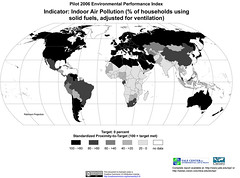 |
| Indoor Air Pollution (Photo credit: SEDACMaps) |
Also discussed here: WHO guidelines for indoor air quality: selected pollutants(484 page pdf, World Health Organization, 2010)
And here: Amendment No. 38 to the Regional Plan (2006)(Official Plan for the Halton Planning Area, Regional Municipality of Halton, Dec. 16, 2009)
Today we review a call for action to the London Assembly (or city council) to improve the level of air quality found indoors where people live and breathe most of the time. While many believe that poor indoor air quality (IAQ) is caused by moulds and volatile gases emitted by furniture and curtains, there is recent evidence that outdoor pollutants such as particulate matter emitted by vehicles can be responsible for up to half the pollution found indoors. Part of the solution is to install very fine filters. Another solution, being pursued in Canada, is to require developers to build homes for the vulnerable populations of children and the elderly at least 30 m away from major roads or 150 m from highways (or provide air quality evidence that it is safe)- as municipal authorities in Halton Region have done recently.
Key Quotes:
“The most common forms of indoor air pollution include: fine combustion particles from traffic and power stations (PM2.5); volcanic dust; bio-aerosols and pathogens like pollen, bacteria, viruses and fungal spores; environmental tobacco smoke (ETS); asbestos; and silica dust. Molecular pollutants such as gases and vapours include: carbon monoxide; oxides of nitrogen (NOx) and sulphur; ozone; radon; and volatile organic compounds (VOCs).”
“Without filters, up to 50% (and much more in some cases) of air pollution found indoors comes from outside”
“Indoor concentrations of some pollutants can be much higher than outdoor (e.g. 10 or 20 times higher in the case of formaldehyde)”
“European citizens spend on average over 90% of their time indoors so 75% or more of the health impact of AAQ can therefore occur indoors.”
“To achieve high IAQ in cities with ambient air exceeding EU limit values by 50% requires a two stage particle filter with a gas filter to achieve average reductions of 80%, 90% or 95% in particles of 0.4 microns in diameter (which compares with the thickness of a human hair of about 70 microns).”
Recommendation:
- “to investigate IAQ with a particular focus on health and energy savings. The investigation should consider buildings with existing mechanical ventilation and others where standalone or ducted air filtration may be needed”
- “"Specifically, an air quality study based on guidelines under Section 143(2.1) is required for such development proposals within 30m of a Major Arterial or Provincial Highway, or 150m of a Provincial Freeway, as defined by Map 3 of this Plan.”




No comments:
Post a Comment